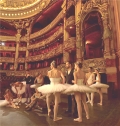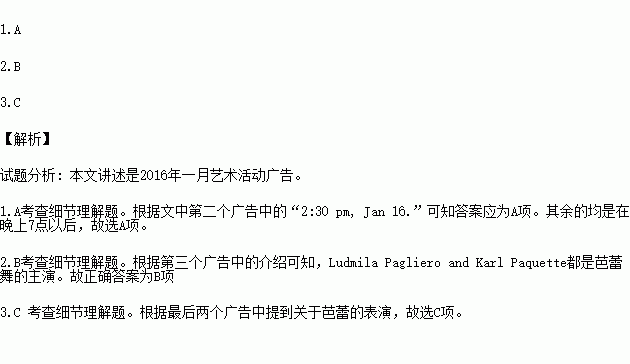题目内容
Art Beat in January 2016
Beijing
Youth choir to perform

The youth choir of China National Symphony Orchestra will soon perform classics including the Mexican folk song, The Golden Nightingale, and the Blue Danube, adapted from a waltz by Johann Strauss II. Pianists Zhao Lin and Wang Tianyang will join in the show.
7:30 pm, Jan 23. Forbidden City Concert Hall, inside Zhongshan Park, west of Tian'anmen Square, Xicheng district. 010-6559-8285.
Orchestra recitals

The China National Center for the Performing Arts Orchestra led by conductor Lyu Jia will give two recitals, featuring works including Beethoven's Coriolanus Overture and Mozart's Symphonies No 40 & No 41 Jupiter. Cellist Wang Jian will join in the performances, playing Schumann's Cello Concerto in A minor, Op 129 and Saint-Saens' Cello Concerto No 1 in A minor, Op 33.
7:30 pm, Jan 15; 2:30 pm, Jan 16. China National Center for the Performing Arts, No 2 West Chang'an Avenue, Xicheng District. 010-6655-0000.
Ballet from Paris

Paris Opera Ballet will present two gala performances in the city. Besides highlights of classical ballet, such as Swan Lake and Manon, the program will also include modern pieces from the company's repertoire. The leading etoiles are Ludmila Pagliero and Karl Paquette.
7:15 pm, Jan 15-16. Shanghai Oriental Art Center, 425 Dingxiang Road, Pudong district. 021-6854-1234.
Ensemble of swans

Shanghai Ballet will present two performances of Swan Lake. The production choreographed by British artist Derek Deane has just completed a tour in 26 cities of the Netherlands. The spectacular production features an ensemble of 48 dancers.
7:15 pm, Jan 22-23. Shanghai Grand Theater, 300 Renmin Avenue, Huangpu district. 400-106-8686.
1.If you only spare some time in the afternoon, you can enjoy ________.
A. Beethoven's Coriolanus Overture
B. Classical ballet Manon
C. The Golden Nightingale
D. Classical ballet Swan Lake
2.According to the text, we know that Ludmila Pagliero and Karl Paquette are ________.
A. Pianists B. ballet performers
C. cellists D. violinists
3.If you are interested in ballet performances, which of the following places can you go to enjoy yourself?
A. Forbidden City Concert Hall and China National Center
B. Forbidden City Concert Hall Shanghai Grand Theater
C. Shanghai Oriental Art Center and Shanghai Grand Theater
D. China National Center and Shanghai Oriental Art Center
请根据句意,选择方框中的单词,用其正确的形式填入下面的句子的空白处,并将答案写在相应位置。
absorb, intend, accuse, approach, amuse, conclude, thorough |
1.This dictionary is __________ for senior high students.
2.It’s too cold for children to play outside today, so they have to __________ themselves indoors.
3.Tony __________ Julia, touched her shoulder and kissed her on the cheek!
4.Once my neighbour next door __________ me of playing the piano too loudly in my room.
5.Having been __________ cleaned, the garden looked more beautiful than ever before.
6.It seems reasonable to __________ that people’s behaviour is influenced by what they see on TV.
7.He was so __________ in reading a novel that he didn’t notice his teacher coming up to him.

